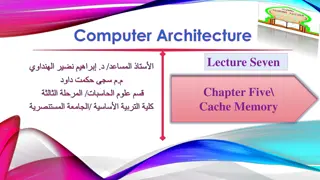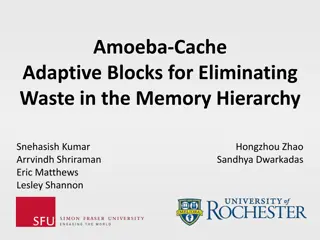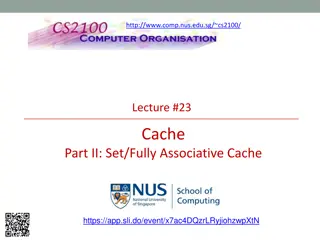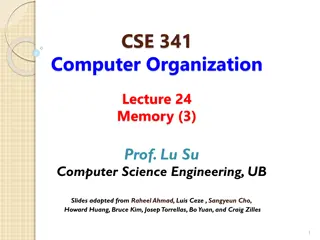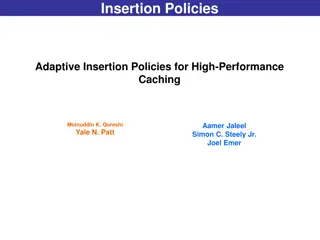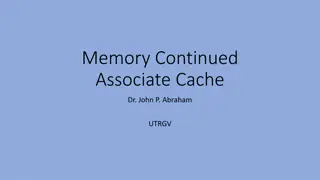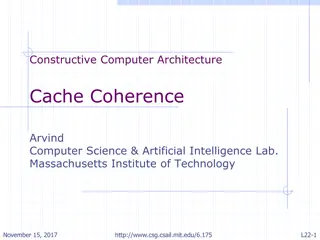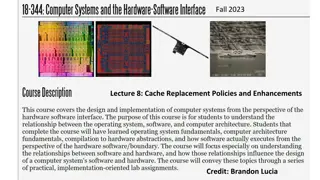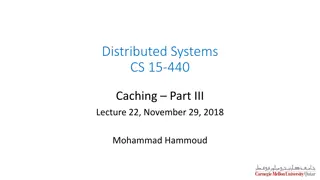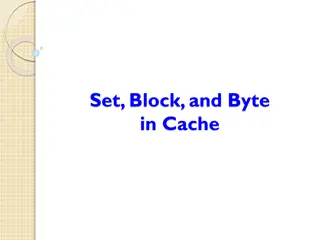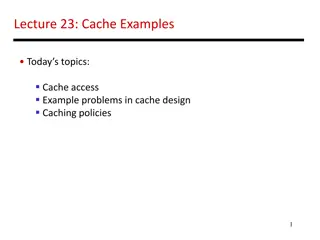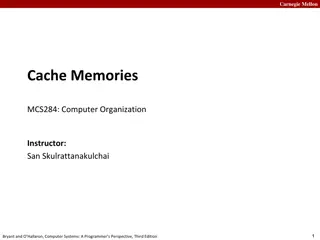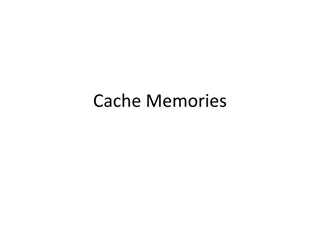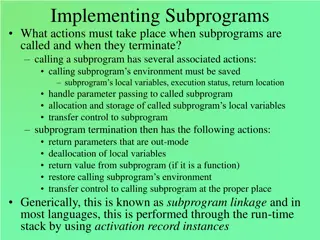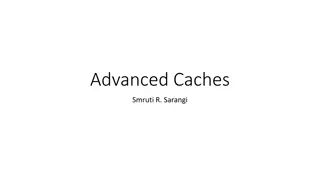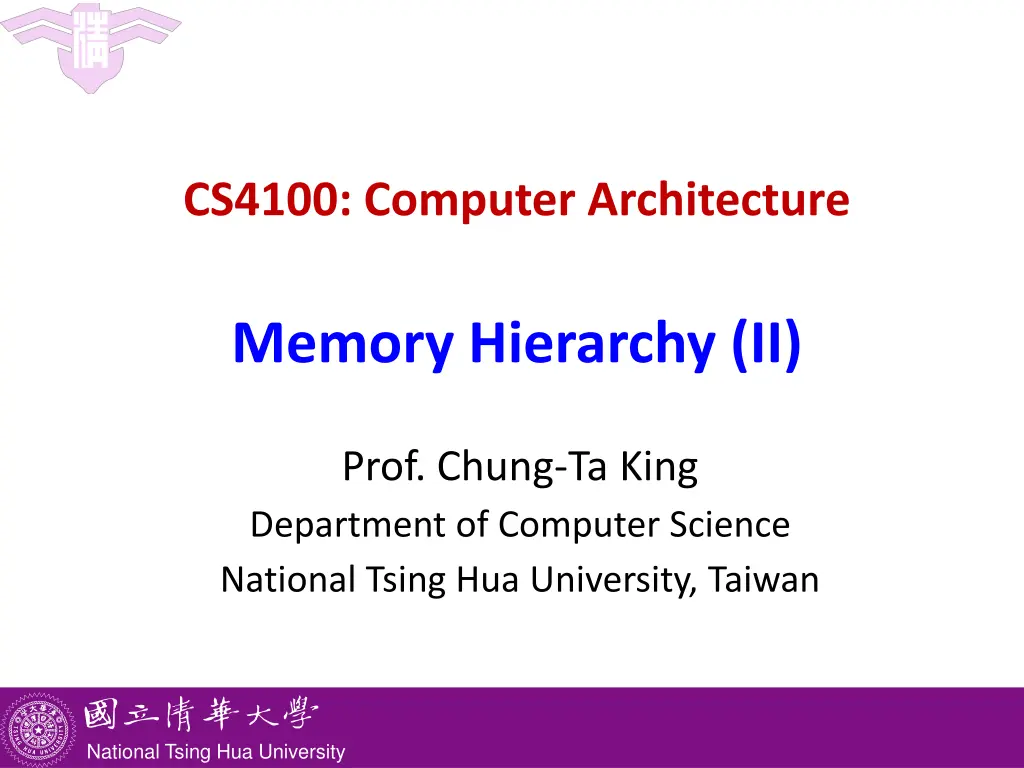
Understanding Computer Architecture Memory Hierarchy at National Tsing Hua University
Explore the memory hierarchy, cache memory, block placement, and block identification in computer architecture. Learn about direct-mapped caches, block identification techniques, and the role of caches in CPU pipelines. Discover the concepts taught by Prof. Chung-Ta King at National Tsing Hua University, Taiwan.
Download Presentation

Please find below an Image/Link to download the presentation.
The content on the website is provided AS IS for your information and personal use only. It may not be sold, licensed, or shared on other websites without obtaining consent from the author. If you encounter any issues during the download, it is possible that the publisher has removed the file from their server.
You are allowed to download the files provided on this website for personal or commercial use, subject to the condition that they are used lawfully. All files are the property of their respective owners.
The content on the website is provided AS IS for your information and personal use only. It may not be sold, licensed, or shared on other websites without obtaining consent from the author.
E N D
Presentation Transcript
CS4100: Computer Architecture Memory Hierarchy (II) Prof. Chung-Ta King Department of Computer Science National Tsing Hua University, Taiwan National Tsing Hua University
Outline Introduction to memory hierarchy (Sec. 5.1) Memory technologies (Sec. 5.2, 5.5) Caches (Sec. 5.3, 5.4, 5.9) Basic organization and design alternatives (Sec. 5.3) Performance and design tradeoffs (Sec. 5.4) Cache controller (Sec. 5.9) Virtual memory (Sec. 5.7) Framework for memory hierarchy (Sec. 5.8) Virtual machines (Sec. 5.6) Parallelism and memory hierarchies (Sec. 5.10, 5.11) 1 National Tsing Hua University
Cache Memory Cache memory The level of the memory hierarchy closest to the CPU Give CPU an illusion of a very fast main memory Target of instruction fetch, ld and sd CPU Registers Instr. operands Cache (SRAM) 4 questions for cache design: Q1: block placement Q2: block identification Q3: block replacement Q4: write policy Blocks Memory (DRAM) Pages Disk 2 National Tsing Hua University
Cache and the CPU Pipeline $ M $ M 3 National Tsing Hua University
Q1: Block Placement Where can a block be placed in upper level (cache)? One fixed location: direct mapped A few locations: set associative Anywhere: fully associative cache Location is determined by address of the block Block placement determines how blocks are identified (Q2) memory 4 National Tsing Hua University
Direct Mapped Cache Direct mapped: only one choice For each block in main memory, there is only one location in cache where it can go (Block address) modulo (#Blocks in cache), where #Blocks is a power of 2 Use low-order address bits Fig. 5.8 5 National Tsing Hua University
Block Identification for Direct Mapped (Q2) Since a block can be stored in only one location in cache, we only need to check that location to find the block simple and fast But, how do we know that location stores the right block, as multiple blocks may be stored there? Store block address as well as the data Actually only need the high-order bits, called the tag What if there is no data in a location? Use valid bit for each location in cache: 1 = present, 0 = not present (initial value) 6 National Tsing Hua University
Organization of Direct Mapped Cache 1024 blocks, 1 word/block Cache index: lower 10 bits Cache tag: upper 52 bits Valid bit (0 on start up) Storage needed (1+52+32)*1024 ? CPU Fig. 5.10 7 National Tsing Hua University
Recall EX Stage of ld Addr 8 National Tsing Hua University
MEM Stage of ld Addr $ M 9 National Tsing Hua University
Direct-Mapped Cache Cache controller Index bits need not be stored and compared 10 National Tsing Hua University
Example of Direct Mapped Cache 8-blocks, 1 word/block, 10-bit address, direct mapped Initial state of the cache: Index V Tag Data 000 N 001 N 010 N 011 N 100 N 101 N 110 N 111 N 11 National Tsing Hua University
Example of Direct Mapped Cache Word addr Binary addr Cache block Hit/miss From CPU Miss 22 0001011000 110 Index V Tag Data 000 N 001 N 010 N 011 N 100 N 101 N N Y 00010 Mem[00 0101 1000] 110 111 N Memory 12 National Tsing Hua University
Example of Direct Mapped Cache Word addr Binary addr Cache block Hit/miss From CPU Miss 26 0001101000 010 Index V Tag Data 000 N 001 N N Y 00011 Mem[00 0110 1000] 010 011 N Memory 100 N 101 N N Y 00010 Mem[00 0101 1000] 110 111 N 13 National Tsing Hua University
Example of Direct Mapped Cache Word addr Binary addr Cache block Hit/miss From CPU Hit 22 0001011000 110 Index V Tag Data 000 N 001 N N Y 00011 Mem[00 0110 1000] 010 011 N 100 N CPU 101 N N Y 00010 Mem[00 0101 1000] 110 111 N 14 National Tsing Hua University
Example of Direct Mapped Cache Word addr Binary addr Cache block Hit/miss From CPU Miss 18 0001001000 010 Replace Index V Tag Data 000 Y 00010 Mem[00 0100 0000] 001 N 00011 00010 N Y Y Mem[00 0110 1000] Mem[00 0100 1000] 010 011 Y 00000 Mem[00 0000 1100] Memory 100 N 101 N N Y 00010 Mem[00 0101 1000] 110 111 N 15 National Tsing Hua University
Cache Misses On cache hit (instruction fetch, ld, sd), CPU proceeds normally On cache miss Stall the CPU pipeline Fetch block from main memory (DRAM) Instruction cache miss: restart instruction fetch Data cache miss: complete data access The time to service a cache miss is called miss penalty Problem with direct mapped: poor temporal locality Many addresses may map to the same location in cache The next time block A is accessed, its entry may be replaced by another block A , even if other entries in cache are free 16 National Tsing Hua University
Other Block Placement Policies Q1: Where can a block be placed in upper level (cache)? One fixed location: direct mapped A few locations: set associative Anywhere: fully associative cache memory 17 National Tsing Hua University
Associative Caches Fully associative: Let a block to go in any cache entry hard to be replaced Replaced only when the cache is full Cache identification: all entries are searched at once to find the block a comparator per entry (expensive) n-way set associative: (a compromise) Each set contains n entries and a given block can go to any entries in a set fewer locations to place Cache identification: Block address determines which set: (Block number) modulo (#Sets in cache) Search all entries in a given set at once n comparators (less expensive) 18 National Tsing Hua University
Associative Cache Example Data R/W and tag search at the same time Data R/W only after tag search & hit/miss decision Fig. 5.14 19 National Tsing Hua University
Spectrum of Associativity For a cache with 8 entries Fig. 5.15 20 National Tsing Hua University
Associativity Example Compare 4-block caches Direct mapped, 2-way set associative, fully associative Block access sequence: 0, 8, 0, 6, 8 Direct mapped: Block address Cache index Hit/miss Cache content after access Blk 1 Mem[0] Mem[8] Mem[0] Mem[0] Mem[8] Blk 0 Blk 2 Blk 3 0 8 0 6 8 0 0 0 2 0 miss miss miss miss miss Mem[6] Mem[6] Space not fully utilized 21 National Tsing Hua University
Associativity Example 2-way set associative: Block address 0 8 0 6 8 Cache index 0 0 0 0 0 Hit/miss Cache content after access Set 0 Mem[0] Mem[0] Mem[8] Mem[0] Mem[8] Mem[0] Mem[6] Mem[8] Mem[6] associativity miss rate Set 1 miss miss hit miss miss Replacement matters Fully associative: Block address 0 8 0 6 8 Hit/miss Cache content after access miss miss hit miss hit Mem[0] Mem[0] Mem[0] Mem[0] Mem[0] Mem[8] Mem[8] Mem[8] Mem[8] Mem[6] Mem[6] 22 National Tsing Hua University
Set Associative Cache Organization Increasing associativity shrinks index, expands tag 54 4-way set associativity 4 comparators Fully associativity no index field Fig. 5.18 23 National Tsing Hua University
Q3: Block Replacement Which block should be replaced on a miss? Direct mapped: no choice Set associative: Prefer non-valid entry, if there is one Otherwise, choose among entries in the set Replacement policy: affect miss rate Ideal: replace the block not to be used farthest in future Least-recently used (LRU): use past history to predict future Hardware chooses the one unused for the longest time Simple for 2-way, too hard > 4-way use approximation Random: Give similar performance as LRU for high associativity 24 National Tsing Hua University
An Approximate LRU A used bit (initial 0) is associated with every block When a block is accessed (hit or miss), its used bit is set to 1 On a replacement, a replacement pointer scans through the blocks to find a block with used bit = 0 to replace Along the way, the replacement pointer also reset the encountered used bits from 1 to 0 Alternatively, if on an access, all other used bits in a set are 1, they are reset to 0 except the bit of the block that is accessed Tag Valid Used Replacement pointer 1 0 0 0 Blocks in a set 1 1 0 25 National Tsing Hua University
Q4: Write Policy On write hit, could just update the block in cache But then cache and memory would be inconsistent Write through: also update memory But makes write hits very long, e.g., if base CPI = 1, 10% of instructions are stores, write to memory takes 100 cycles Effective CPI = 1 + 0.1 100 = 11 Solution: write buffer Holds data waiting to be written to memory CPU continues as if write is done, and stalls on write only if write buffer is full Processor Cache Memory Write Buffer 26 National Tsing Hua University
Write Policy Alternative: Write back On write hit, only update block in cache but not in memory Faster write hits, less traffic to memory But cache and memory are inconsistent Need to track whether a block is dirty, by adding a dirty bit to each cache block When a dirty block is to be replaced by a newly requested block, write it back to memory longer read/write misses Can use the write buffer to hold the write-back block while the newly requested block is read from memory. The write- back block is later written back to memory. 27 National Tsing Hua University
Write Policy How to handle the write-missed block, which is in the memory? For write through Write allocate on miss: fetch the block into cache So that later reads from the block will hit No write allocate: don t fetch the block into cache Since programs often write a whole array before reading it, e.g., initialization Also, writes usually end a series of computations For write back Usually fetch the block into cache (write allocate) 28 National Tsing Hua University
Example: Write Through with Allocate Write hit: direct mapped Memory Index 000 001 010 011 100 101 110 111 V Y N Y Y N N Y N Tag 00010 Data A 88 D Write buffer sw E M[72] 72 B E E 00011 00000 B C E CPU 64 A hit 12 C Z 00010 D 8 0 29 National Tsing Hua University
Example: Write Through with Allocate Write miss: direct mapped Memory Index 000 001 010 011 100 101 110 111 V Y N Y Y N N Y N Tag 00010 Data A 88 D Write buffer sw X M[8] 72 E X 00000 Z X 00011 00000 E C CPU 64 A miss Z 12 C Z X 00010 D 8 0 What happen on read miss, e.g., lw x2 M[72]? 30 National Tsing Hua University
Example: Write Through with No-Allocate Write miss under no write allocate Memory Index 000 001 010 011 100 101 110 111 V Y N Y Y N N Y N Tag 00010 Data A 88 D Write buffer sw X M[8] 72 E X 00011 00000 E C CPU 64 A miss 12 C Z X 00010 D 8 0 31 National Tsing Hua University
Example: Write Back Write hit: direct mapped Initially, cache contents consistent with memory Memory Index 000 001 010 011 100 101 110 111 V Y N Y Y N N Y N D N Tag 00010 Data A 88 D Write buffer sw E M[72] 72 B N N 00011 00000 B C Y E CPU 64 A hit 12 C Z N 00010 D 8 0 32 National Tsing Hua University
Example: Write Back Write miss: direct mapped Normally with write allocate Memory Index 000 001 010 011 100 101 110 111 V Y N Y Y N N Y N D N Tag 00010 Data A 88 D Write buffer sw X M[8] 72 B E E Y N 00011 00000 E C 00000 Z X CPU 64 A miss Z 12 C Z N 00010 D 8 0 What happen on read miss, e.g., lw x2 M[72]? 33 National Tsing Hua University
Summary: Comparing Cache Organizations Direct mapped cache: Simple and cheaper to implement: Only one location to store a block in the cache only one location to check (by simple indexing) and replace Faster in detecting a cache hit and to replace: Read data and tag at same time; compare only one tag Poor temporal locality higher miss rate N-way set-associative cache: A block has a choice of N locations higher hit rate More expensive: N comparators, larger tag field Slower: Extra MUX delay to select a block from the set Data comes AFTER hit/miss decision and set selection 34 National Tsing Hua University
Outline Introduction to memory hierarchy (Sec. 5.1) Memory technologies (Sec. 5.2, 5.5) Caches (Sec. 5.3, 5.4, 5.9) Basic organization and design alternatives (Sec. 5.3) Performance and design tradeoffs (Sec. 5.4) Cache controller (Sec. 5.9) Virtual memory (Sec. 5.7) Framework for memory hierarchy (Sec. 5.8) Virtual machines (Sec. 5.6) Parallelism and memory hierarchies (Sec. 5.10, 5.11) 35 National Tsing Hua University
CPU Performance with Cache CPU time = (CPU execution cycles + Memory stall cycles) Clock cycle time CPU execution cycles: includes cache hit time Memory stall cycles: mainly from cache misses Memory stall cycles =Memory accesses Program =Instructions Program Assuming: R/W have same miss rates and penalty; write buffer stalls ignored Miss rate Miss penalty Misses Instruction Miss penalty 36 National Tsing Hua University
Cache Performance Example Given I-cache miss rate = 2% D-cache miss rate = 4% Miss penalty = 100 cycles Base CPI (ideal cache) = 2 Load and stores are 36% of instructions Miss cycles per instruction = misses/instr. penalty I-cache: 0.02 100 = 2 cycles/instruction D-cache: 0.36 0.04 100 = 1.44 cycles/instruction Actual CPI = 2 + 2 + 1.44 = 5.44 cycles/instruction Ideal CPU is 5.44/2 =2.72 times faster 37 National Tsing Hua University
Average Memory Access Time Hit time, though counted in CPU execution cycle, cannot be ignored in considering CPU performance Tend to increase with more flexible and complex cache designs may dominate the improvement in hit rate Consider Average memory access time (AMAT) AMAT = Hit time + Miss rate Miss penalty Example: AMAT per instruction CPU with 1ns clock, hit time = 1 cycle, miss penalty = 20 cycles, miss rate = 0.05 misses per instruction R/W miss penalties are the same; ignore other write stalls AMAT/instruction = 1 + 0.05 20 = 2ns 2 cycles per instruction 38 National Tsing Hua University
Main Memory Supporting Caches Use DRAMs for main memory Fixed width (e.g., 1 word) Connected by fixed-width clocked bus Bus clock is typically slower than CPU clock Example cache block read 1 bus cycle for address transfer 15 bus cycles per DRAM access 1 bus cycle per data transfer To read a 4-word block with a 1-word-wide memory Miss penalty = 1 + 4 15 + 4 1 = 65 bus cycles Bandwidth = 16 bytes / 65 cycles = 0.25 B/cycle 39 National Tsing Hua University
Main Memory Supporting Caches 4-word wide memory Miss penalty = 1 + 15 + 1 = 17 bus cycles Bandwidth = 16 bytes / 17 cycles = 0.94 B/cycle 4-bank interleaved memory Miss penalty = 1 + 15 + 4 1 = 20 bus cycles Bandwidth = 16 bytes / 20 cycles = 0.8 B/cycle 40 National Tsing Hua University
Implications of Cache Performance When CPU performance is increased Miss penalty becomes more significant Decreasing base CPI Greater proportion of time spent on memory stalls Increasing clock rate Memory stalls account for more CPU cycles Can t neglect cache behavior when evaluating system performance 41 National Tsing Hua University
Sources of Cache Misses Compulsory (cold start) misses: First access to a block, not much we can do Solution: larger block size Conflict (collision) misses: >1 memory blocks mapped to same location Solution 1: increase cache size Solution 2: increase associativity Capacity misses: Cache cannot hold all blocks needed by program execution; a replaced block is later accessed again Solution: increase cache size 42 National Tsing Hua University
Cache Design Space Many interacting dimensions Cache size Block size Associativity Replacement policy Write-through vs write-back Write allocation The optimal choice is a compromise Depends on access characteristics Workload, use (I-cache, D-cache) Depends on technology and cost Simplicity often wins Cache Size Associativity Block Size Bad Factor A Factor B Good Less More 43 National Tsing Hua University
Design Tradeoff: Increase Block Size Instead of 1024 blocks and 4 bytes/block, can organize the cache as 256 blocks and 16 bytes/block 63 12 11 4 3 0 Tag 52 bits Index 8 bits Offset 4 bits To what block number does address 4500 map? Block address = 4500/16 = 281 4500=00 0010001100101002 /100002 00 001000110012 Block number = 281 modulo 256 = 25 = 000110012 44 National Tsing Hua University
Block Size Considerations Larger blocks should reduce miss rate (compulsory misses) due to spatial locality But in a fixed-sized cache Larger blocks fewer of them More competition increased miss rate (capacity misses) Larger blocks have larger miss penalty Can offset benefit of reduced miss rate Early restart and critical-word-first can help Miss Penalty Miss RateExploits spatial locality Fewer blocks: compromises temporal locality Ave. Access Time Increased miss penalty and miss rate Block Size Block Size Block Size 45 National Tsing Hua University
Design Tradeoff: How Much Associativity Increasing associativity decreases miss rate (conflict misses) But with diminishing returns Also increases cost (e.g., more comparators) and hit time Simulation of a system with 64KB D-cache, 16-word blocks, SPEC2000 1-way: 10.3% 2-way: 8.6% 4-way: 8.3% 8-way: 8.1% 46 National Tsing Hua University
Optimization: Multilevel Caches Why multilevel cache? Primary cache (Level-1) attached to CPU Small, but fast Level-2 cache services misses from primary cache Larger, slower, but still faster than main memory Reduce miss penalty Main memory services L-2 cache misses Some high-end systems include L-3 cache 47 National Tsing Hua University
Multilevel Cache Example Given CPU base CPI = 1, clock rate = 4GHz cycle time = 0.25ns Miss rate/instruction = 2%, Memory access time = 100ns With just primary (L-1) cache Miss penalty = 100ns/0.25ns = 400 cycles Effective CPI = 1 + 0.02 400 = 9 cycles/instruction Now add L-2 cache Access time = 5ns, miss rate to main memory = 0.5% L-1 cache miss penalty with L-2 hit = 5ns/0.25ns = 20 cycles L-1 cache miss penalty with L-2 miss = 400 cycles CPI = 1 + 0.02 20 + 0.005 400 = 3.4 cycles/instruction Performance ratio = 9/3.4 = 2.6 48 National Tsing Hua University
Multilevel Cache Considerations Primary cache Focus on minimal hit time to give a shorter clock cycle or fewer pipeline stages L-2 cache Focus on low miss rate to avoid main memory access Hit time has less overall impact Results L-1 cache usually smaller than a single-level cache, with a block size smaller than in L-2 to match smaller cache and reduce miss penalty L2 cache much larger than 1-level cache (for access time less critical); larger block size, higher associativity than L-1 49 National Tsing Hua University


